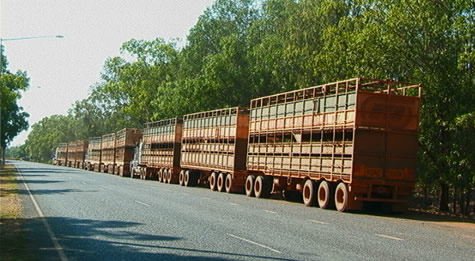THEME: Road Trains
SUBJECT AREA: history
TOPIC: transition from cattle drives to truck drives
After World War II, the global demand for cattle and beef from Australia became strong worldwide, but particularly from Britain. The vast distances between cattle stations and the length of time it took to drive cattle cross country for shipments to worldwide markets proved quite a challenge as well as time consuming.
In the 1930s, the development of a vehicle designed to haul large numbers of cattle began in earnest. This early day mode of transportation was referred to as a ‘road train’ due to their ability to haul several trailers pulled by a large truck resembling a railroad engine and cattle cars. Due to the lack of major railway lines in the Northern Territory, road trains seemed the next best thing.

The next challenge to be dealt with in this fledgling transportation industry was the roads or lack thereof. In the early days of cattle stations, horses had been used to pack in supplies to the remote outstations and people didn’t travel often for leisure. In the Victoria River District, where the cattle industry thrived, acceptable roads for transporting cattle to markets was a necessity. Vesteys, a huge British company that owned more than 100,000 sq. kilometres of stations in the Territory, developed the ‘road train’ for cattle hauling and the Commonwealth government began pouring money into ‘beef roads’. By 1975, $30 million had been spent on over 2500 km of roads. One of these single lane bitumen roads is the Delamere Road, which runs from the Victoria Highway to Wave Hill station (once a Vesteys property).
Today’s road trains continually haul cattle around the Territory. Designed with two decks, (an upper and lower deck) the trailers can haul on the average, approximately twenty head per level, or forty head per trailer depending upon the size of the cattle. Three trailers (the most one truck can haul and equal to nine and one half car lengths!) can transport over 100 head of cattle at a time. Beef transportation has come a long way in seventy years!
Suggested learning activities: Investigate the development of the transportation industry in your area. How is it related to other area industries as far as the transporting of goods and products? Is the agriculture industry in your region dependent upon transportation and, if so, in what respects? Compare and contrast the trucking industry in your area with the road trains in Australia’s Outback regions. (Consider total truck length/tonnage allowed on the restricted roadways)
April